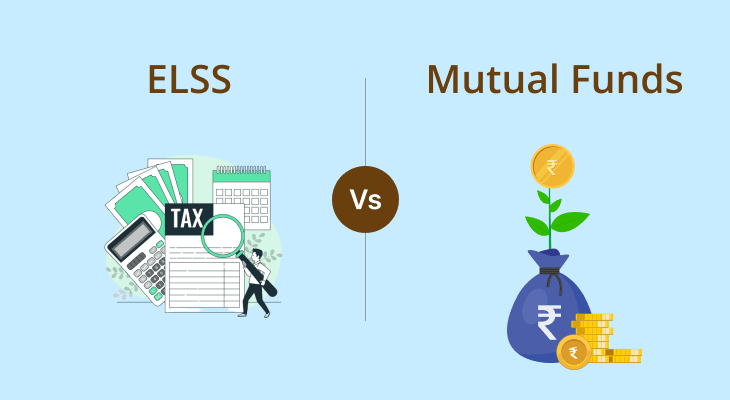
Table of content
ELSS vs Mutual Funds - Key Differences and Which is Better
Mutual funds offer a wide range of investment options to cater to different financial goals, risk appetites, and investment horizons. Among them, ELSS (Equity Linked Savings Scheme) stands out due to its tax-saving benefits under Section 80C of the Income Tax Act. However, investors often struggle to decide between ELSS and other mutual funds when planning their investments.
This article provides a detailed comparison of ELSS vs Mutual Funds, explaining their differences, advantages, and suitability for different investors. By the end, you will be able to answer "Is ELSS better than MF?" based on your needs.
What is ELSS (Equity Linked Savings Scheme)?
ELSS (Equity Linked Savings Scheme) is a type of equity mutual fund that comes with tax-saving benefits under Section 80C. It primarily invests in equities and equity-related instruments, aiming for long-term capital appreciation.
Key Features of ELSS:
- Tax Benefits: Investments in ELSS qualify for deductions of up to ₹ 1.5 Lakhs under Section 80C.
- Lock-in Period: ELSS has a mandatory lock-in of 3 years, which is the least among other popular tax-saving investment options.
- Market-Linked Returns: Since ELSS invests in equities, returns are market-dependent and can fluctuate.
- Growth and Dividend Options: Investors can choose between growth (capital appreciation) and dividend (periodic payouts) options.
- High Risk, High Reward: Being equity-oriented, ELSS carries higher risks but offers the potential for superior long-term gains.
What are Mutual Funds?
A mutual fund is an investment vehicle that pools capital from various investors and invests it in a diversified portfolio of equity, debt, and other types of assets, depending on the type of fund. These funds are managed by professional fund managers, who make investment decisions based on the fund’s objective. Mutual funds are suitable for investors who want to grow their wealth over time without actively managing their investments. Unlike ELSS, mutual funds are not restricted to equities and do not have tax-saving benefits.
Types of Mutual Funds:
Mutual funds are categorised based on their investment structure, asset allocation, and objectives.
1. Based on Asset Class
- Equity Mutual Funds – Invest primarily in stocks and have the potential for high returns, but come with higher risks.
- Debt Mutual Funds – Invest in fixed-income securities like government bonds, corporate bonds, and treasury bills, with lower risk.
- Hybrid Mutual Funds – A mix of equity and debt, balancing risk and return for investors who want moderate growth with reduced volatility.
- Commodity Mutual Funds – Invest in commodities like gold and silver, offering an alternative investment avenue.
- Real Estate Funds – These funds invest in real estate projects, REITs, or real estate-related companies.
2. Based on Structure
- Open-Ended Mutual Funds – Allow investors to buy and sell units anytime, offering high liquidity.
- Close-Ended Mutual Funds – Have a fixed tenure and can only be redeemed after maturity.
- Interval Funds – A hybrid between open-ended and close-ended funds, allowing investors to redeem units at specific intervals.
3. Based on Investment Goals
- Growth Funds – Aim for capital appreciation by investing in high-growth stocks.
- Income Funds – Focus on generating regular income through dividends and interest.
- Index Funds & ETFs – Passively track a market index like NIFTY 50 or SENSEX, offering lower expense ratios.
- Sectoral/Thematic Funds – Focus on specific sectors like IT, pharma, or infrastructure. These are high-risk, high-reward investments.
Key Features of Mutual Funds
- Diversification – Spreads investment across various asset classes, reducing overall risk.
- Professional Fund Management – Managed by experts who analyze and select investments.
- Liquidity – Open-ended funds allow investors to redeem their investments anytime.
- Systematic Investment Plan (SIP) – Allows investors to invest small amounts regularly, promoting disciplined investing.
- Risk-Based Categories – Investors can choose between low, moderate, and high-risk funds.
- Transparency – Fund houses provide regular reports on NAV, holdings, and fund performance.
- Regulation & Security – Mutual funds in India, including ELSS, are regulated by SEBI (Securities and Exchange Board of India), ensuring investor protection.
Key Differences Between ELSS and Mutual Funds
The table below highlights the difference between ELSS and Mutual Fund investments:
Aspect | ELSS | Other Mutual Funds |
Purpose | Primarily for tax-saving under Section 80C | Wealth creation, income generation, or liquidity |
Tax Benefits | Eligible for ₹1.5 lakh deduction under Section 80C | No tax benefits (except for retirement or tax-saving funds) |
Lock-in Period | 3 years | No lock-in (except close-ended funds) |
Investment Type | Invests mainly in equities | Can invest in equities, debt, or hybrid instruments |
Risk Level | High, due to equity exposure | Varies (equity funds are risky, debt funds are low risk) |
Liquidity | Low (since funds are locked for 3 years) | High, as most mutual funds allow redemption anytime |
Return Potential | Higher in the long term | Varies based on fund type |
SIP Availability | Yes | Yes |
Capital Gains Tax | LTCG (above ₹1.25 lakh taxed at 12.5%), STCG taxed at 20% | LTCG/STCG tax depends on fund type (equity or debt) |
Advantages of Investing in ELSS
- Tax Savings: ELSS is one of the best options under Section 80C for reducing taxable income.
- Shortest Lock-in Among Tax-Saving Investments: Compared to PPF (15 years) and NSC (5 years), ELSS has a much shorter lock-in.
- Potential for High Returns: Since ELSS is an equity-focused fund, it has the potential to deliver inflation-beating returns over the long term.
- Encourages Long-Term Investing: The 3-year lock-in period ensures you stay invested, benefiting from market uptrends.
- SIP Flexibility: You can start with as little as ₹500 per month via SIP.
Advantages of Investing in Mutual Funds
- Variety of Investment Options: You can choose from equity, debt, hybrid, index, and sectoral mutual funds based on their risk profile.
- No Lock-in Period: Most mutual funds offer high liquidity with no mandatory holding period.
- Risk Diversification: Unlike ELSS, which is fully equity-oriented, other mutual funds offer diversification with debt and hybrid options.
- Suitable for Short, Medium, and Long-Term Goals: Mutual funds cater to different time horizons.
- Professional Fund Management: Fund managers make strategic decisions to maximise returns while managing risks.
Which is Better: ELSS or Mutual Funds?
Choosing between ELSS vs Mutual Funds depends on your financial goals and risk appetite.
Choose ELSS if:
- You need tax-saving benefits under Section 80C.
- You are comfortable with a 3-year lock-in.
- You have a long-term investment horizon and want equity exposure.
Choose Mutual Funds if:
- You need high liquidity and flexibility.
- You want diversified options across equity, debt, and hybrid funds.
- You are investing for short-term or medium-term goals.
For tax benefits, ELSS is a clear winner. For broader investment options, mutual funds are better.
Conclusion
Both ELSS and mutual funds serve different investment purposes. If your goal is tax savings and long-term wealth creation, ELSS is the better option. However, if you are looking for flexibility, diversified options, and liquidity, mutual funds are the way to go.
Before investing, assess your financial goals, risk appetite, and investment horizon to make an informed decision. If tax saving is not your priority, diversified mutual funds can offer more options tailored to your needs.
FAQ
What is the main difference between ELSS and mutual funds?
ELSS is a tax-saving equity mutual fund with a 3-year lock-in period and tax benefits under Section 80C. Regular mutual funds do not offer tax benefits and come in various types, including equity, debt, and hybrid.
Is ELSS better than other mutual funds?
ELSS offers tax savings and high growth potential, making it ideal for long-term investors. However, it has a lock-in period, whereas other mutual funds provide more flexibility. The choice depends on your tax planning needs, investment horizon, and risk appetite.
How does the lock-in period affect ELSS investments?
ELSS has a mandatory 3-year lock-in period, meaning investors cannot withdraw before that. This encourages long-term wealth creation but limits liquidity. Regular mutual funds, especially open-ended ones, offer better liquidity, allowing withdrawals anytime.
Which has a higher return potential: ELSS or mutual funds?
ELSS primarily invests in equities, similar to equity mutual funds, offering high growth potential. However, returns depend on market conditions. Other mutual funds, like debt or hybrid funds, offer lower but more stable returns.
Can I invest in ELSS through SIPs?
Yes, you can invest in ELSS via Systematic Investment Plans (SIPs), but each SIP installment is locked in for three years from the date of investment. This means withdrawals will be staggered based on the SIP schedule.
Are ELSS funds riskier than other mutual funds?
Yes, ELSS is an equity-based mutual fund, making it riskier than debt or hybrid funds. However, its long-term investment horizon helps mitigate short-term market volatility and provides potential for wealth accumulation.
How are ELSS and mutual funds taxed?
ELSS investments qualify for tax deductions up to ₹1.5 lakh under Section 80C. Capital gains up to ₹1.25 lakh per year are tax-free, while gains above that attract 12.5% LTCG tax. Other mutual funds have different tax structures depending on the type of fund.
Can I redeem ELSS funds after 3 years?
Yes, after the 3-year lock-in period, you can redeem or stay invested. Many investors continue holding ELSS for long-term benefits, similar to regular equity mutual funds.
Which is better for short-term goals: ELSS or mutual funds?
For short-term goals, debt or hybrid mutual funds are better as they offer stability and liquidity. ELSS is designed for long-term tax-saving investments and is not ideal for short-term financial needs.
Should I invest in both ELSS and mutual funds?
Yes, diversifying your portfolio with both ELSS and other mutual funds balances tax savings, liquidity, and risk. While ELSS reduces taxable income, other mutual funds cater to different financial goals, offering flexibility in investment planning.


